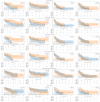Peripheral Blood Mononuclear Cells Predict Therapeutic Efficacy of Immunotherapy in NSCLC
- PMID: 35740564
- PMCID: PMC9221141
- DOI: 10.3390/cancers14122898
Peripheral Blood Mononuclear Cells Predict Therapeutic Efficacy of Immunotherapy in NSCLC
Abstract
In lung cancer immunotherapy, biomarkers to guide clinical decisions are limited. We now explore whether the detailed immunophenotyping of circulating peripheral blood mononuclear cells (PBMCs) can predict the efficacy of anti-PD-1 immunotherapy in patients with advanced non-small-cell lung cancer (NSCLC). We determined 107 PBMCs subpopulations in a prospective cohort of NSCLC patients before starting single-agent anti-PD-1 immunotherapy (study group), analyzed by flow cytometry. As a control group, we studied patients with advanced malignancies before initiating non-immunotherapy treatment. The frequency of PBMCs was correlated with treatment outcome. Patients were categorized as having either high or low expression for each biomarker, defined as those above the 55th or below the 45th percentile of the overall marker expression within the cohort. In the study group, three subpopulations were associated with significant differences in outcome: high pretreatment levels of circulating CD4+CCR9+, CD4+CCR10+, or CD8+CXCR4+ T cells correlated with poorer overall survival (15.7 vs. 35.9 months, HR 0.16, p = 0.003; 22.0 vs. NR months, HR 0.10, p = 0.003, and 22.0 vs. NR months, HR 0.29, p = 0.02). These differences were specific to immunotherapy-treated patients. High baseline levels of circulating T cell subpopulations related to tissue lymphocyte recruitment are associated with poorer outcomes of immunotherapy-treated advanced NSCLC patients.
Keywords: anti-PD-1 antibodies; biomarkers; immunotherapy; non-small cell lung cancer; peripheral blood mononuclear cells.
Conflict of interest statement
Jacobo Rogado reports personal fees from Roche, AstraZeneca, Merck, Ferrer, Persan Farma, Fresenius Kabi; travel expenses from MSD, BMS, Roche, and AstraZeneca; and advisor consultancies from Fresenius Kabi. Nuria Romero reports advisory consultancies from Ipsen, Janssen, Clovis, and Astra Zeneca and research funding from Janssen, MSD, and Pfizer. Ramon Colomer reports research funding from Roche, Janssen, BMS, and MSD. All of the declared conflicts of interest are outside of the submitted work. All other authors have no conflict to declare.
Figures



References
-
- Ready N., Hellmann M.D., Awad M.M., Otterson G.A., Gutierrez M., Gainor J.F., Borghaei H., Jolivet J., Horn L., Mates M., et al. First-Line Nivolumab Plus Ipilimumab in Advanced Non-Small-Cell Lung Cancer (CheckMate 568): Outcomes by Programmed Death Ligand 1 and Tumor Mutational Burden as Biomarkers. J. Clin. Oncol. 2019;37:992–1000. doi: 10.1200/JCO.18.01042. - DOI - PMC - PubMed
Grants and funding
- PIE15/00068/Instituto de Salud Carlos III
- PI17/01865/Instituto de Salud Carlos III
- PI20/01458/Instituto de Salud Carlos III
- PI19/01491/Instituto de Salud Carlos III
- CIBER Cardiovascular (Fondo de Investigación Sanitaria del Instituto de Salud Carlos III with co-funding from the Fondo Europeo de Desarrollo Regional FEDER)/Instituto de Salud Carlos III
- Project RETOS RTI2018-097596-B-I00 (AEI/10.13039/501100011033 MCI / FEDER, UE)/Instituto de Salud Carlos III
- PI17/00801/Instituto de Salud Carlos III
- PI21/01111/Instituto de Salud Carlos III
- JR17/00007/Instituto de Salud Carlos III
- Project Molecular analysis of the Exhaled Breath Condensate in the management of solitary pulmonary nodule (Ideas semilla AECC 2019)/Fundación Científica de la Asociación Española Contra el Cáncer
LinkOut - more resources
Full Text Sources
Research Materials

